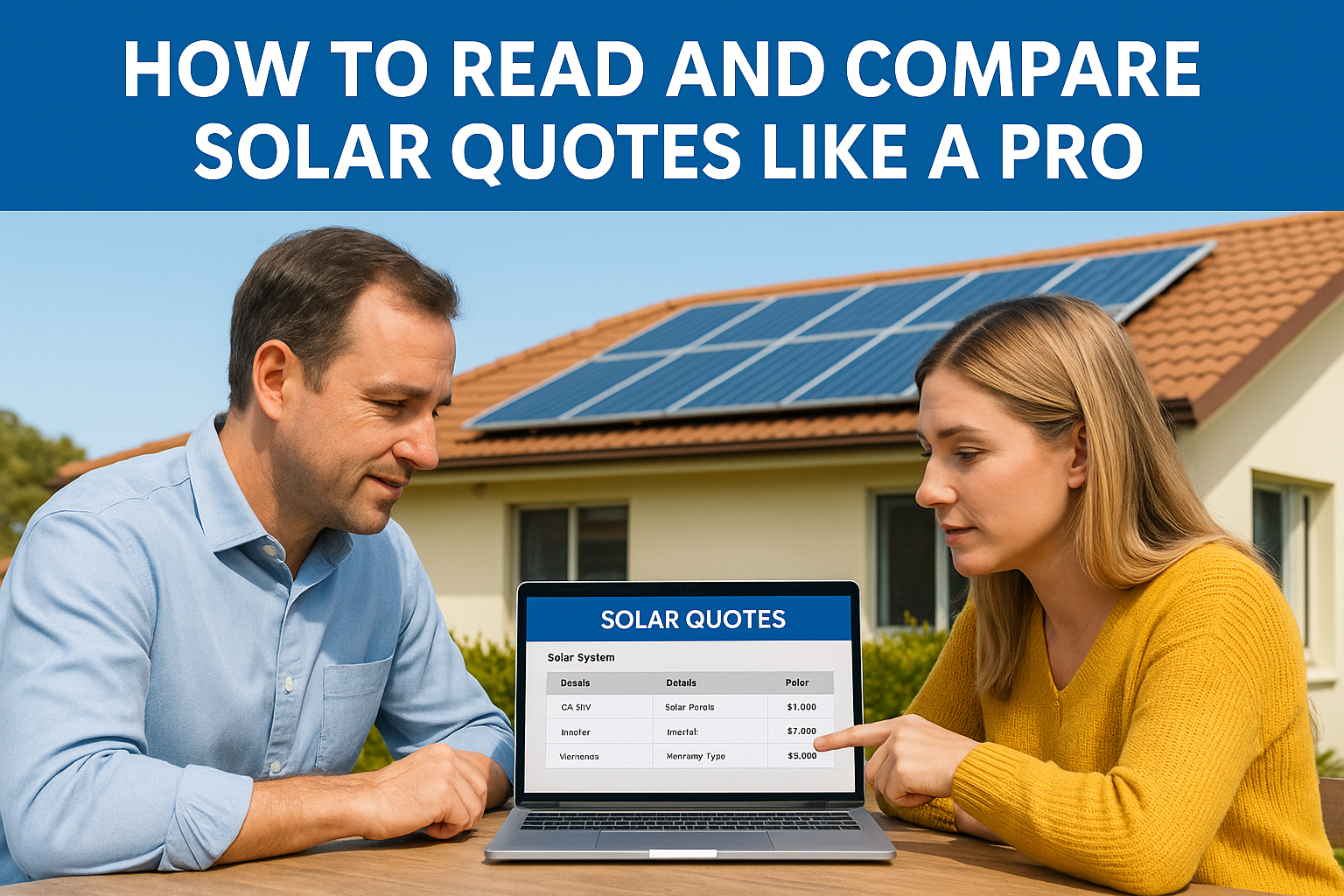Installing solar power is one of the smartest ways to cut electricity bills in 2025 — but comparing quotes can be confusing. You may receive multiple offers that all look similar, yet differ greatly in quality, performance, and long-term value.
Learning how to read and compare solar quotes properly helps you make an informed decision that saves you money and ensures your system performs efficiently for decades.
Why Comparing Solar Quotes Matters
Not all solar systems are created equal. Even when two quotes look similar on paper, small differences in equipment, installation quality, or warranties can dramatically affect performance.
By carefully comparing your solar quotes, you can:
- Identify better-quality equipment and avoid cheap imitations
- Understand your true return on investment
- Detect hidden fees or misleading offers
- Ensure your system meets Australian energy standards
A little extra research at the start ensures you get a system that performs well and lasts longer.
1. Start by Checking System Size and Output
Every solar quote should clearly state the system size in kilowatts (kW) — typically between 3kW and 10kW for most Australian homes. However, size alone doesn’t tell the full story. You also need to know how much energy (in kWh per year) it will generate.
The amount of power your system produces depends on your location, roof direction, and sunlight hours. For example, a 6.6kW system in Queensland will produce more power than the same system in Victoria due to sunnier conditions.
For accurate system sizing advice, visit the official government guide: Energy.gov.au – Size Your Solar System.
Tip: Use this guide to cross-check your installer’s recommendations and make sure the system size suits your household’s energy needs.
2. Compare Solar Panel Brands and Efficiency
Panels make up the largest part of your system’s performance. Always check:
- Brand and model number (e.g., REC, Trina, Jinko, Qcells)
- Efficiency rating (higher = better performance)
- Warranty length (look for 25 years minimum on panels)
Avoid vague descriptions like “Tier 1 panels” without model details. This label only refers to financial stability, not actual product quality.
3. Examine the Inverter – The System’s Heart
Your inverter converts solar energy into usable power for your home. It’s responsible for overall efficiency, so it must be reliable.
Check for:
- Brand reputation (e.g., Fronius, Sungrow, Enphase)
- Efficiency rating (ideally 97% or higher)
- Warranty period (10 years or more recommended)
- Monitoring features (apps that show performance in real time)
Pro Tip: Avoid inverters from unknown brands or systems without monitoring — these often fail sooner and cost more long-term.
4. Look Beyond the Total Price
While the lowest quote might look attractive, cheaper systems often come with lower-quality parts, shorter warranties, and unreliable support.
Instead of comparing only total price, consider:
- Price per kW installed
- Included components (panels, inverter, mounting, monitoring)
- After-sales support and installation warranty
Ask for a clear breakdown of rebates and STCs (Small-scale Technology Certificates). Reputable installers will include these in your quote.
5. Review the Warranties Carefully
Solar systems come with multiple warranties:
- Panel product warranty – Covers defects (usually 10–25 years).
- Performance warranty – Guarantees power output over 25 years.
- Inverter warranty – Typically 10 years.
- Workmanship warranty – Covers installation quality (5–10 years).
Make sure your installer offers local warranty support in case of issues.
6. Verify Installer Accreditation
Always choose a Clean Energy Council (CEC)–accredited installer. This ensures your system is eligible for rebates and meets Australian safety standards.
Tip: You can look up accredited installers on the CEC website to confirm their certification before signing any agreement.
7. Compare System Monitoring and Aftercare
A quality solar system includes monitoring software that tracks performance. This helps you detect issues early and ensures your system performs as expected.
If one quote includes detailed monitoring and another doesn’t, consider this when comparing value — not just price.
8. Get Multiple Quotes to Compare
The easiest way to ensure you’re getting the right deal is to compare several quotes from accredited installers.
Request Free Solar Quotes Here: https://quotes.solarproof.com.au/request-solar-quotes/
With Solar Proof, you can:
- Compare pricing from verified CEC-accredited installers
- Review equipment quality, warranties, and inclusions
- Find transparent, no-obligation quotes tailored to your home
Combining your quote comparisons with sizing guidance from Energy.gov.au gives you a complete, confident view before you buy.
Example: Comparing Two Real Quotes
| Quote | Price | Panels | Inverter | Warranty | Output (kWh/year) |
|---|---|---|---|---|---|
| A | $5,400 | Jinko 440W | Fronius Primo | 25 yrs panels / 10 yrs inverter | 9,600 |
| B | $4,800 | Generic 400W | Unknown Brand | 10 yrs panel / 5 yrs inverter | 8,200 |
Even though Quote B is cheaper, Quote A offers better efficiency, longer warranties, and more energy output — providing higher long-term savings.
Final Takeaway
Knowing how to compare solar quotes empowers you to make confident, informed decisions. Don’t focus on price alone — check system size, equipment quality, and installer reputation.
Start your journey by reviewing the government’s sizing guide and then get multiple quotes from trusted experts.
Step 1: Learn your ideal system size → Energy.gov.au – Size Your Solar System
Step 2: Compare installer quotes → Request Solar Quotes
Together, these tools help you design a powerful, affordable solar system tailored to your home.

